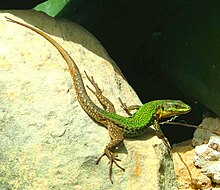Filfola lizard
| Maltese wall lizard | |
|---|---|

| |
| In Marsaxlokk, Malta | |
| Scientific classification | |
| Domain: | Eukaryota |
| Kingdom: | Animalia |
| Phylum: | Chordata |
| Class: | Reptilia |
| Order: | Squamata |
| Family: | Lacertidae |
| Genus: | Podarcis |
| Species: | P. filfolensis
|
| Binomial name | |
| Podarcis filfolensis (Bedriaga, 1876)
| |

| |
The filfola lizard or Maltese wall lizard (Podarcis filfolensis) is a species of lizard in the family Lacertidae. It is found in Italy (in the Pelagian Islands) and in the island group of Malta. Its natural habitats are Mediterranean-type shrubby vegetation, rocky areas, rocky shores, arable land, pastureland, and rural gardens.
P. filfolensis in Malta
[edit]In the Maltese Islands, there are four subspecies of the Maltese wall lizard, all of which are endemic there.
Podarcis filfolensis ssp. maltensis
[edit]
This subspecies is found on the three main islands: Malta, Gozo and Comino. It is normally greenish and sometimes speckled.[2]
Podarcis filfolensis ssp. filfolensis
[edit]
This subspecies is endemic to the islet of Filfla just off the coast of Malta. It is the largest of the four subspecies and is blackish with bluish spots.[2]
Podarcis filfolensis ssp. kieselbachi
[edit]
This subspecies is endemic to Selmunett, otherwise known as St.Paul's Islands. Its colours vary greatly e.g. brown, grey, etc. with an orange belly and small black spots. The population became extinct in 2005.[2]
Podarcis filfolensis ssp. generalensis
[edit]
This subspecies is endemic to Fungus Rock (west coast of Gozo). It has a reddish belly and blue-like flanks.[2]
Other subspecies
[edit]
A fifth subspecies is thought to exist on the island of Cominotto/Kemunett [2] and another subspecies, Podarcis filfolensis ssp. laurentimulleri, occurs on the Italian islands of Linosa and Lampione.[3]
Features and behaviour
[edit]Unlike the males, who have bright colours, young lizards and females have somewhat dull coloration (brownish).[2] The Maltese wall lizard usually eats small insects like ants or termites.
Males show territorial behaviour. When other males enter its territory, it puffs up and raises its head. A similar behaviour is seen when they attract females. Mating takes place in spring. One or two eggs are laid shortly after, and finally hatch between June and mid-August.[2]
See also
[edit]References and sources
[edit]- ^ Claudia Corti, Valentin Pérez-Mellado, Roberto Sindaco, Antonio Romano (2009). "Podarcis filfolensis". IUCN Red List of Threatened Species. 2009: e.T17793A7479516. doi:10.2305/IUCN.UK.2009.RLTS.T17793A7479516.en. Retrieved 16 November 2021.
{{cite journal}}: CS1 maint: multiple names: authors list (link) - ^ a b c d e f g Wildlife of the Maltese Islands, BirdLife Malta and Nature Trust, 1995
- ^ Nature in Gozo, BirdLife Malta, 2007
- Savona-Ventura C. Taxonomical status of the Maltese wall lizard (Podarcis filfolensis BEDRIAGA 1876). Central Mediterranean Naturalist 2001, 3(3):89-95
- Savona-Ventura C. The herpetofauna of Comino and satellite islets with a note on the colouration of Podarcis filfolensis. Animalia 1983; 10(1/3):87-93
- Savona-Ventura C. The Natural History of St. Paul's Islands - Reptiles and Mammals. Potamon 1983; 11:32-34
- Savona-Ventura C. Reptiles and amphibians in Maltese ecology. Potamon 1979; 1(2):14-16
- Sciberras, A. (2005) Observation on the endangered population of the Maltese wall lizard of Selmunett island (Podarcis filfolensis kieselbachi).Unpublished work, presented to the chamber of young scientists of Malta at 4–10 April, winning the contest 1st place and leading to the Belgian Science expo on 26 April to 1 May.
- Sciberras, A. (2007) Lizards At Id-Dwejra. Dwejra Heritage Park Gozo pgs.28-33. Dwejra Management Board.
- Sciberras, A. & Schembri,P.J. (2008) Conservation Status of St Paul's Island Wall Lizard (Podarcis filfolensis kieselbachi). Herpetological Bulletin-Number 105 pgs.28-34.

